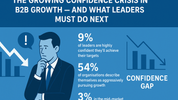I'm constantly amazed at how many people have anxiety around posting and generating 'creative' ideas on all social platforms.
Now I also see a lot of folks on here proclaiming themselves as 'Thought Leaders' which is utter nonsense. Surely this is something other people say if you are, or if you are not.
I also see far too many companies with 'gated' content, which means in order for me to access it I have to reluctantly provide you with all my contact details so you can 'spam' me.
But, lets not lose sight of how valuable being perceived as a 'thought leader' by potential prospects is an extremely valuable badge of honour to be given on social media platforms, and in particular on LinkedIn.
In my experience leadership teams and marketers extremely underestimate the value of thought leadership.
A recent study showed that 58% of c-suite decision makers say they decide which businesses to work with after seeing their thought leadership. Only 26% of sellers see the value.
So when you see, or hear about your competitors winning business that you think should be yours maybe, just maybe they understand the real value around whats required to become a thought leader.
Maybe they have already started on that journey and upskilling the team, and its probably a result of this that they are now more 'front of mind' to the prospects than you are is probably the key reason you lose, each and every time.
But it does highlight the underlying value of LinkedIn, and how so many companies and individuals simply don't use it for anything other than FOMO.
For many sales people, “social selling” is the vague idea of being exceptionally active on social media to drive conversions. In practice, the average salesperson rarely goes beyond adding LinkedIn connections and sending the odd follow-up message—a dramatic under use of the marketing potential of LinkedIn.
Before you dive into using LinkedIn specifically, let’s review the basic stages of a social sales funnel:
- Exposure—The prospect hears about your company’s products and services.
- Interest-building—The prospect dives deeper into the value propositions of your products and services.
- Lead generation—The prospect opts into ongoing communication from your business.
- Lead nurturing—The prospect gets the pitch and ongoing information that drives and nudges them toward the sale.
- Conversion—The prospect becomes a customer.
- Retention—The customer interacts with your customer success team and receives ongoing messaging from you to drive repeat conversions and loyalty.
- Word of mouth—The customer talks about the experience (either positive or negative) to their social network.
In your world, you might call this a customer journey and have different definitions for each stage.
However, this general framework is universal for the most part and helps us map the various ways we can influence a prospect and customer during the sales process.
I love LinkedIn, but the platform has long felt like the estranged uncle who’s wickedly smart and brimming with potential but putters along unremarkably, much to the surprise of the people around him who see what he could be and want him to realize that potential. For social media marketers trying to use LinkedIn for marketing and sales, that’s a special kind of frustration. It feels like we should be killing it, but many of us aren’t.
https://www.socialmediaexaminer.com/how-to-get-linkedin-leads-without-advertising/?omhide=true
 unknownx500
unknownx500











